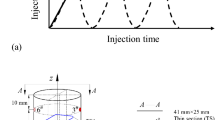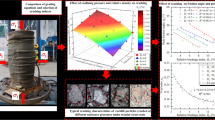Abstract
Granular salt has been proposed as backfill material in drifts and shafts of a nuclear waste disposal facility where it will serve to conduct heat away from the waste to the host rock. Creep closure of excavations in rock salt will consolidate (reduce the porosity of) the granular salt. This study involved measuring the thermal conductivity and specific heat of granular salt as a function of porosity and temperature to aid in understanding how thermal properties will change during granular salt consolidation accomplished at pressures and temperatures consistent with a nuclear waste disposal facility. Thermal properties of samples from laboratory-consolidated granular salt and in situ consolidated granular salt were measured using a transient plane source method at temperatures ranging from 50 to 250 °C. Additional measurements were taken on a single crystal of halite and dilated polycrystalline rock salt. Thermal conductivity of granular salt decreased with increases in temperature and porosity. Specific heat of granular salt at lower temperatures decreased with increasing porosity. At higher temperatures, porosity dependence was not apparent. The thermal conductivity and specific heat data were fit to empirical models and compared with results presented in the literature. At comparable densities, the thermal conductivities of granular salt samples consolidated hydrostatically in this study were greater than those measured previously on samples formed by quasi-static pressing. Petrographic studies of the consolidated salt indicate that the consolidation method influenced the nature of the porosity; these observations are used to explain the variation of measured thermal conductivities between the two consolidation methods. Thermal conductivity of dilated polycrystalline salt was lower than consolidated salt at comparable porosities. The pervasive crack network along grain boundaries in dilated salt impedes heat flow and results in a lower thermal conductivity compared to hydrostatically consolidated salt.









Similar content being viewed by others
References
Acton U (1977) Thermal conductivity of S.E. New Mexico Rocksalt and Anhydrites. In: International conference on thermal conductivity, Ottawa, pp 263–276
Anovitz LM, Cole DR (2015) Characterization and analysis of porosity and pore structures. Rev Miner Geochem 80:61–164
Bahrami M, Ahadi M, Andisheh-Tadbir M, Tam M (2016) An improved transient plane source method for measuring thermal conductivity of thin films: deconvoluting thermal contact resistance. Int J Heat Mass Transf 96:371–380. https://doi.org/10.1016/j.ijheatmasstransfer.2016.01.037
Bauer S, Urquhart A (2015) Thermal and physical properties of reconsolidated crushed rock salt as a function of porosity and temperature. Acta Geotech. https://doi.org/10.1007/s11440-015-0414-8
Beauheim RL, Roberts RM (2002) Hydrology and hydraulic properties of a bedded evaporite formation. J Hydrol 259:66–88
Bechthold W, Rothfuchs T, Poley A, Ghoreychi M, Heusermann S, Gens A, Olivella S (1999) Backfilling and sealing of underground repositories for radioactive waste in salt (Bambus Project): Final Report. EUR 19124 EN. European Commission, Brussels
Bechthold W, Smailos E, Heusermann S, Bollingerfehr W, Bazargan Sabet B, Rothfuchs T, Kamlot P, Grupa J, Olivella S, Hansen F (2004) Backfilling and sealing of underground repositories for radioactive waste in salt (Bambus II Project): Final Report. EUR 20621 EN. European Commission, Luxembourg
Birch F, Clark H (1940) The thermal conductivity of rock and its dependence upon temperature and composition: part I. Am J Sci 238:529–558
Broome ST, Bauer SJ, Hansen FD (2014) Reconsolidation of crushed salt to 250 °C under hydrostatic and shear stress conditions. In: 48th US rock mechanics/geomechanics symposium, Minneapolis
Carter N, Hansen FD (1983) Creep of rocksalt. Tectonophysics 92:275–333
Clark Jr SP (1969) Heat conductivity in the mantle. In: Hart PJ (ed) The earth’s crust and upper mantle. American Geophysical Union Geophysical Monograph vol 13. Washington, pp 622–626
Clauser C, Huenges E (1995) Thermal conductivity of rocks and minerals. In: A handbook of physical constants. AGU Reference Shelf 3. American Geophysical Union, pp 105–125
Coberly CJ, Stevens AB (1933) Development of hydrogen porosimeter. Society of Petroleum Engineers. SPE-933261-G, pp 261–269
Conca J, Sage S, Wright J (2005) Nuclear energy and waste disposal in the age of fuel recycling. N M J Sci 45:13–21
Cosenza P, Ghoreychia M, Bazargan-Sabeta B, de Marsily G (1999) In situ rock salt permeability measurement for long term safety assessment of storage. Int J Rock Mech Min Sci Geomech Abstr 36:509–526
Damveld H, Bannink D (2012) Management of spent fuel and radioactive waste. State of affairs, a worldwide overview. Nucl Monit 746/7/8
Durham WB, Abey AE (1981) Thermal properties of Avery Island salt to 573 K and 50-MPa confining pressure. Lawrence Livermore National Laboratory, Livermore. UCRL-53128
Hansen FD (2016) Characterization of reconsolidated crushed salt from the BAMBUS Site. SAND2016-2794. Sandia National Laboratories, Albuquerque
Hansen FD, Carter NL (1980) Creep of rock salt at elevated temperature. In: Summers DA (ed) Proceedings of 21st U.S. symposium on rock mechanics. University of Missouri, Rolla, pp 217–226
Hansen F, Popp T, Wieczorek K, Stuhrenberg D (2014) Granular salt summary: reconsolidation principles and applications. SAND2014-16141R. Sandia National Laboratories, Albuquerque
Holcomb DJ, Shields M (1987) Hydrostatic creep consolidation of crushed salt with added water. SAND87-1990. Sandia National Laboratories, Albuquerque
Joy AF (1957) Thermal conductivity of insulation containing moisture. ASTM International, West Conshohocken, pp 65–67
Jury WA, Horton R (2004) Soil physics, 6th edn. Wiley, Hoboken, pp 180–182
Macaulay DB, Bouazza A, Wang B, Singh RM (2015) Evaluation of thermal conductivity of models. Can Geotech J 52:1892–1900
Martin BL, Rutqvist J, Birkholzer JT (2015) Long-term modeling of the thermal-hydraulic-mechanical response of a generic salt repository for heat-generating nuclear waste. Eng Geol 193:198–211. https://doi.org/10.1016/j.enggeo.2015.04.014
Mellegard K, Callahan G, Hansen F (2013) High-temperature characterization of bedded Permian salt. 47th US rock mechanics/geomechanics symposium
National Research Council (2001) Disposition of high level waste and spent nuclear fuel. Committee on Disposition of High Level Radioactive Waste through Geological Isolation. Board of Radioactive Waste Management, pp 22–26. ISBN: 0-309-56764-5
Smith D (1976) Thermal conductivity of halite using a pulsed laser. Report no.: Y/DA-7013. Oak Ridge (TN): Oak Ridge Y- Plant; 1976. Contract no.: W- 7405-eng-26. Supported by the US Energy Research and Development Administration
Spiers CJ, Brzesowsky RH (1993) Densification behavior of wet granular salt: theory versus experiment. Seventh symposium on salt, 1993. vol I. Elsevier Science Publishers, B.V., Amsterdam
Stein CL (1985) Mineralogy in the waste isolation pilot plant (WIPP) facility stratigraphic horizon. SAND85-0321. Sandia National Laboratories, Albuquerque
Stormont JC, Daemen JJK (1992) Laboratory study of gas permeability changes in rock salt during deformation. Int J Rock Mech Min Sci Geomech 29(4):325–342
Stormont JC, Finley RE (1996) Sealing boreholes in rock salt. In: Fuenkajorn K, Daemen JJK (eds) Sealing of boreholes and underground excavations in rock. Chapman and Hall, London, pp 204–209. doi:10.1007/978-94-009-1505-3
Sweet JN, McCreight JE (1979) Thermal conductivity of rocksalt and other geologic materials from the site of the proposed waste isolation pilot plant. SAND79-1134. Sandia National Laboratories, Albuquerque
Urquhart A, Bauer S (2015) Experimental determination of single-crystal halite thermal conductivity, diffusivity and specific heat from – 75 to 300 °C. Int J Rock Mech Min Sci 78:350–352. https://doi.org/10.1016/j.ijrmms.2015.04.007
van den Broek WMGT (1982) Impurities in rock-salt: consequences for the temperature increases at the disposal of high-level nuclear waste. PB-83-102087. Technische Hogeschool Delft, Netherlands
von Berlepsch T, Haverkamp B (2016) Salt as a host rock for the geological repository for nuclear waste. 1811-5209/16/0012-0257$2.50. Elements, vol 12, pp 257–262. https://doi.org/doi:10.2113/gselements.12.4.257
Woodside W, Messmer JH (1961a) Thermal conductivity of porous media. I. Unconsolidated sands. J Appl Phys 32(9):1688–1699
Woodside W, Messmer JH (1961b) Thermal conductivity of porous media. II. Consolidated rocks. J Appl Phys 32(9):1699–1706
Yang JM (1981) Thermophysical properties. In: Gevantman LH (ed) Physical properties data for rock salt. Monograph 167. National Bureau of Standards, Washington, pp 206–212
Acknowledgements
Funding was provided through the Department of Energy’s Nuclear Energy University Program (Grant DE-NE0000733). Sandia National Laboratories is a multi-programme laboratory managed and operated by Sandia Corporation, a wholly owned subsidiary of Lockheed Martin Corporation, for the US Department of Energy’s National Nuclear Security Administration under Contract DE-AC04-94AL85000.
Author information
Authors and Affiliations
Corresponding author
Rights and permissions
About this article
Cite this article
Paneru, L.P., Bauer, S.J. & Stormont, J.C. Thermal Properties of Consolidated Granular Salt as a Backfill Material. Rock Mech Rock Eng 51, 911–923 (2018). https://doi.org/10.1007/s00603-017-1353-5
Received:
Accepted:
Published:
Issue Date:
DOI: https://doi.org/10.1007/s00603-017-1353-5




